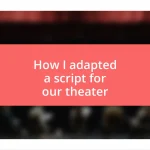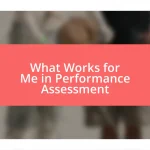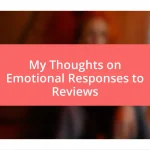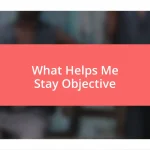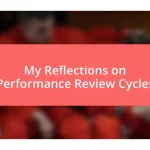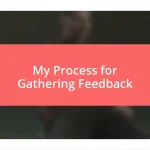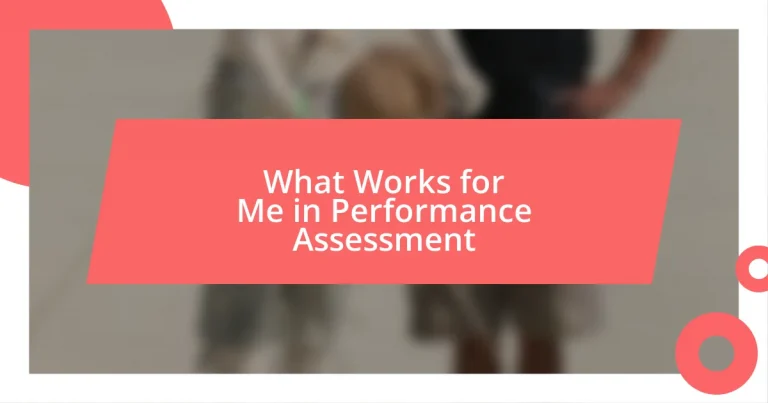Key takeaways:
- Performance assessment methods, including portfolios and formative assessments, provide valuable insights into student learning and progress.
- Involving students in selecting assessment criteria enhances engagement, ownership, and alignment with learning objectives.
- Continuous reflection and feedback in the assessment process foster a culture of improvement and empower students to take charge of their learning journey.
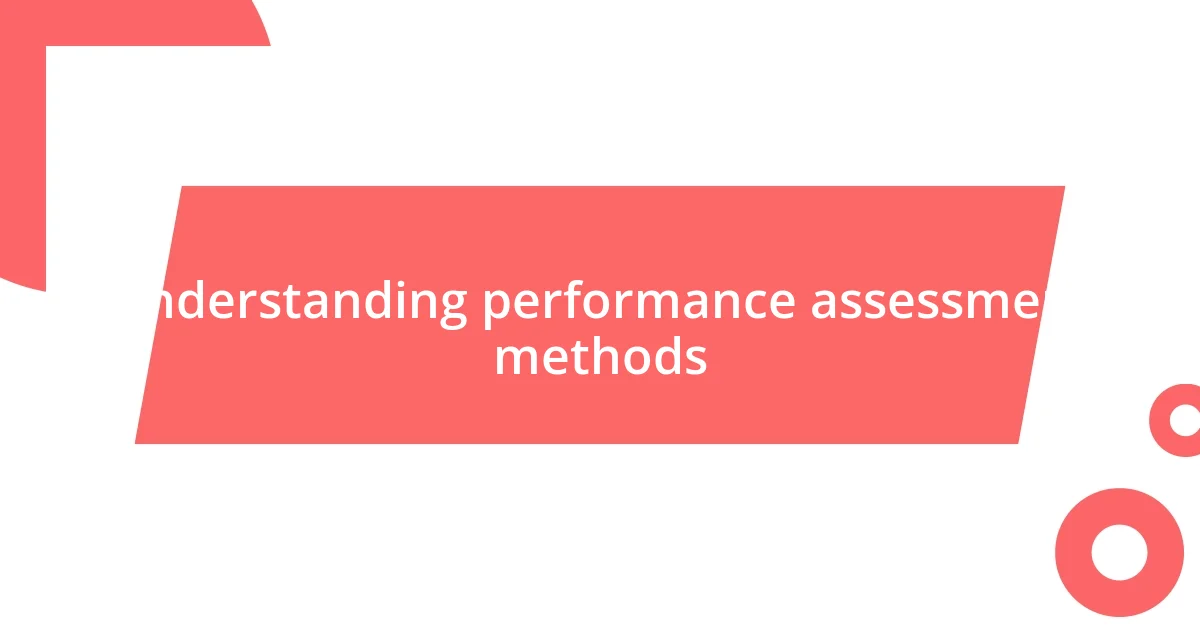
Understanding performance assessment methods
When I think about performance assessment methods, I’m often reminded of my own experiences with them in various educational settings. There’s something incredibly powerful about using tools like portfolios or self-assessments; they allow learners to showcase their growth over time and reflect on their own learning journeys. Have you ever considered how much insight can come from simply asking students to evaluate their own work?
Additionally, formative assessments, like quizzes or group discussions, provide immediate feedback that helps both teachers and students steer the learning process effectively. I vividly recall a group project where we utilized peer feedback; it not only deepened our understanding but also strengthened our collaboration skills. Isn’t it fascinating how diverse methods can reveal different strengths and areas for improvement?
Finally, summative assessments are usually what we think of when considering performance assessments. I remember feeling that pressure during finals week, and while they do measure knowledge accumulation, they often don’t capture the full spectrum of a student’s abilities. How effective can they truly be in assessing what a learner can do in real-world situations? It leaves me pondering the balance we need in using various methods to paint a complete picture of student performance.
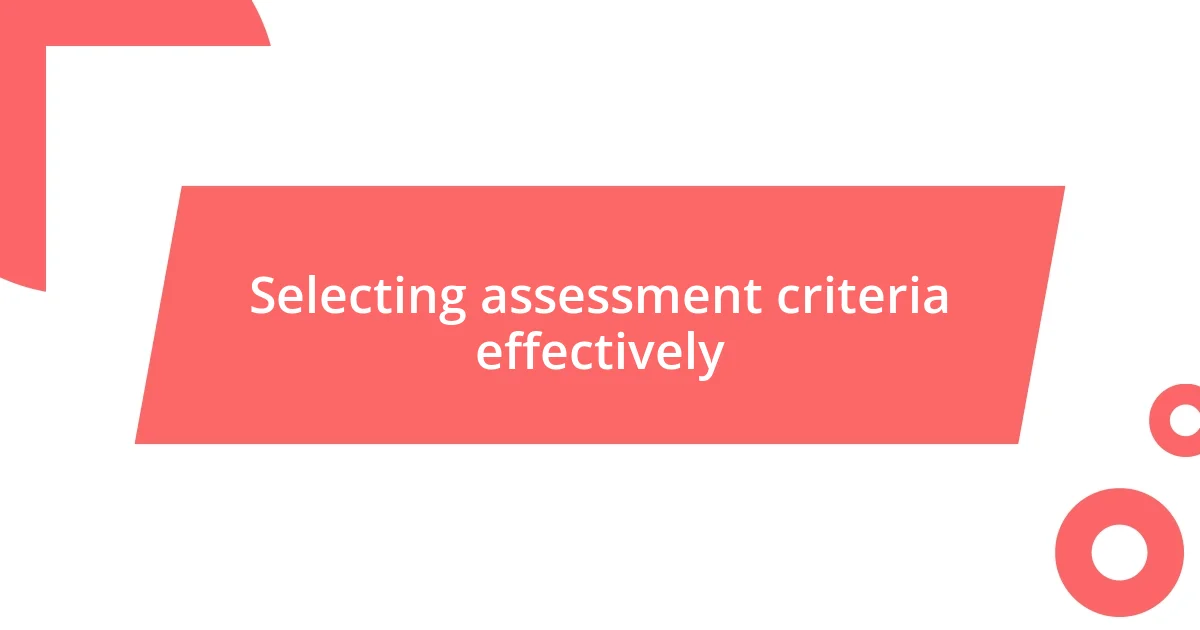
Selecting assessment criteria effectively
Selecting assessment criteria effectively is a nuanced process that requires thoughtful consideration. In my experience, clarity is vital; when the criteria are well-defined, students understand expectations, which can alleviate a lot of anxiety. I recall a time when I was unsure about grading criteria for an important project, and it led to confusion and frustration—not just for me, but also for my classmates. Clear criteria create a sense of security and can motivate learners to put forth their best effort.
I’ve found that involving students in the selection of assessment criteria can foster a sense of ownership in their learning. During one class, we collaboratively developed the criteria for a group presentation, which led to motivated teams working creatively. Isn’t it amazing how a simple shift can increase engagement? This co-creation not only gave us clear guidelines, but it also made the assessment process feel more equitable and relevant.
Moreover, it’s crucial to align assessment criteria with learning objectives. Reflecting on my education, I’ve seen firsthand how misalignment can result in superficial learning experiences. For example, in a course where the criteria stressed memorization over application, I struggled to connect the concepts to real-world scenarios. Aligning criteria with clear learning goals ensures that assessments truly measure what we aim to teach—a vital aspect for meaningful education.
| Assessment Type | Criteria Focus |
|---|---|
| Clear Criteria | Understanding Expectations |
| Student Involvement | Engagement and Ownership |
| Alignment with Objectives | Meaningful Learning |
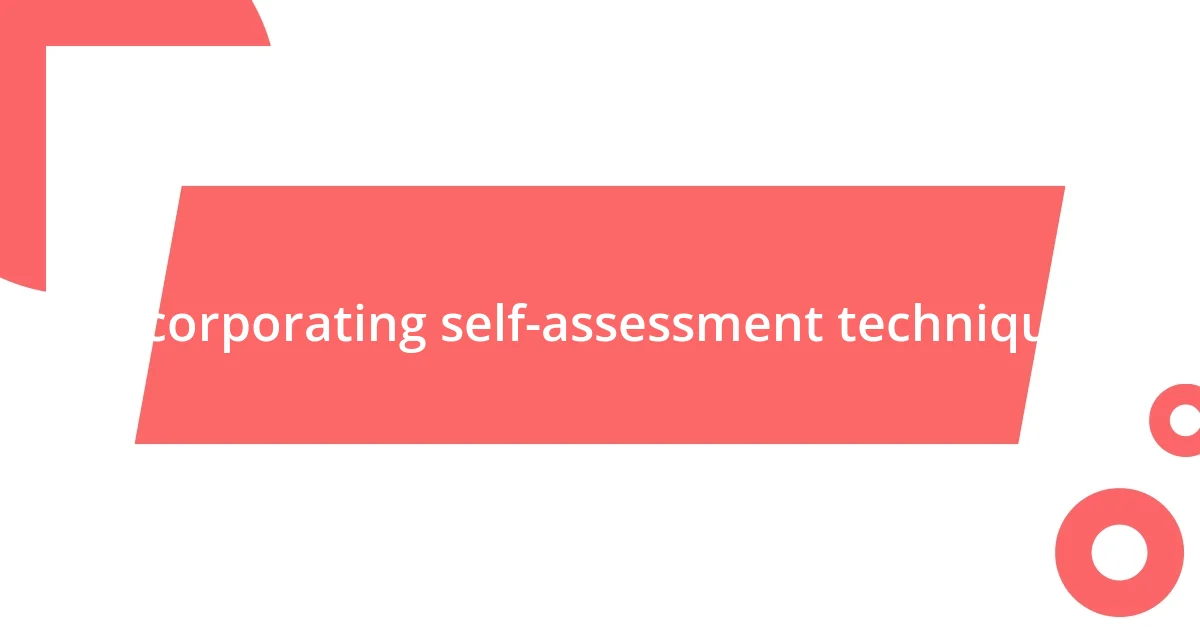
Incorporating self-assessment techniques
Incorporating self-assessment techniques into performance assessments can be a game-changer for both students and educators. I remember introducing self-assessment in one of my classes, and the response was transformative. Watching students take ownership of their learning and articulate their strengths and areas for growth brought a unique energy to the room. It’s fascinating how self-reflection not only empowers students but fosters a deeper understanding of their learning processes.
Here’s a list of effective self-assessment techniques that I’ve found particularly valuable:
– Reflective Journals: Students write about their learning experiences, which helps them identify moments of success and challenge.
– Goal Setting: Having students establish personal learning goals encourages them to monitor their progress over time.
– Peer Review: Implementing structured peer assessment can elevate self-awareness by letting students see their work through the eyes of others.
– Rubric Evaluation: Allowing students to use established rubrics to assess their own work makes them more attuned to performance expectations.
– Exit Tickets: Quick reflections on what they learned and what they found challenging can help students process their learning immediately.
By integrating these techniques, I noticed an increased sense of accountability and motivation among my students. It’s one of those moments where you realize that the act of assessing oneself is not just about grades; it’s about growth and a deeper connection to the learning journey.
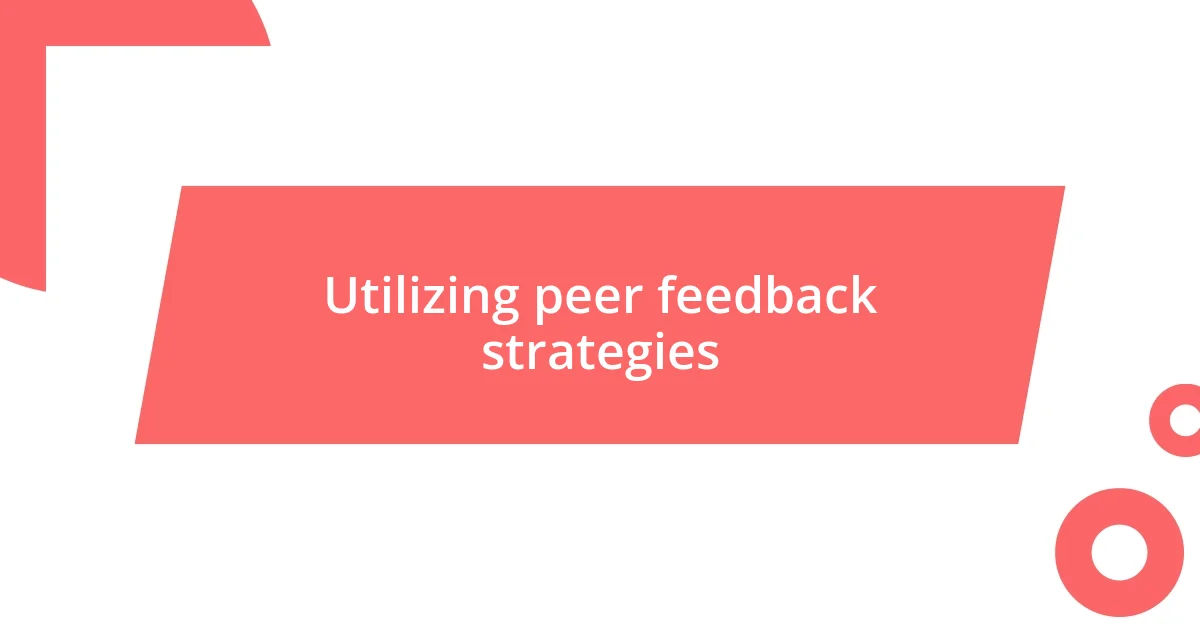
Utilizing peer feedback strategies
Utilizing peer feedback strategies can be a powerful addition to the performance assessment landscape. I recall a peer review session I organized for a writing assignment, and the energy in the room was palpable. It amazed me to see how students eagerly provided feedback to one another, learning not only from their critiques but also from the different perspectives they encountered. Isn’t it eye-opening how we often overlook the insights our peers can offer?
One technique that’s worked wonders for me is establishing clear guidelines for the peer feedback process. When I first tried this, I used a simple checklist to steer students in giving constructive feedback. The change was remarkable! Students became more confident in their evaluations, understanding that their insights were essential to their classmates’ growth. It’s empowering to realize that their voices matter and can positively influence the learning environment.
Perhaps the most surprising benefit of peer feedback I’ve experienced is the sense of community it fosters among students. I once facilitated a project where students exchanged feedback, and the camaraderie that developed was heartwarming. They became invested in each other’s success, supporting one another beyond the classroom. This interconnectedness is a clear reminder of how collaboration enriches the learning experience, don’t you think?
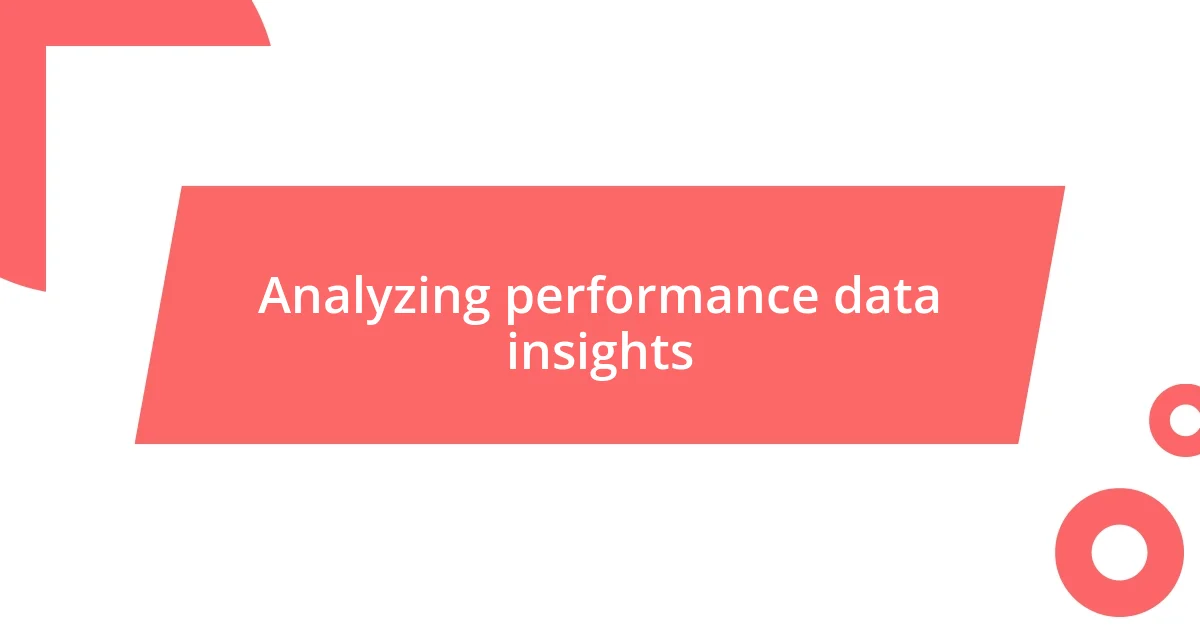
Analyzing performance data insights
Analyzing performance data insights is a crucial aspect of understanding student growth and areas needing improvement. I remember a time when I meticulously reviewed a set of exam results and uncovered patterns I hadn’t anticipated. The data highlighted that certain concepts were tripping up my students—not because they couldn’t grasp them, but due to gaps in prior knowledge. Isn’t it striking how numbers can tell a story we sometimes miss in the classroom?
Diving deep into assessment results has also helped me refine my teaching strategies. After analyzing performance data, I identified that a specific demographic of students consistently performed below expectations. By addressing this disparity with targeted interventions, I not only gained insight into their unique challenges but also built stronger connections with those students. Have you ever experienced that moment when a simple look into data transforms your teaching approach?
Moreover, utilizing visual tools like graphs and charts has made understanding these insights much more engaging. I vividly recall creating a visual representation of student performance trends over time, and it was enlightening to see how certain teaching methods correlated with improvements. These visuals not only clarify the data but also become conversation starters during faculty meetings. Engaging others in discussions about these insights often uncovers even more layers of understanding. How often do we let such data guide our decisions instead of merely reporting it?
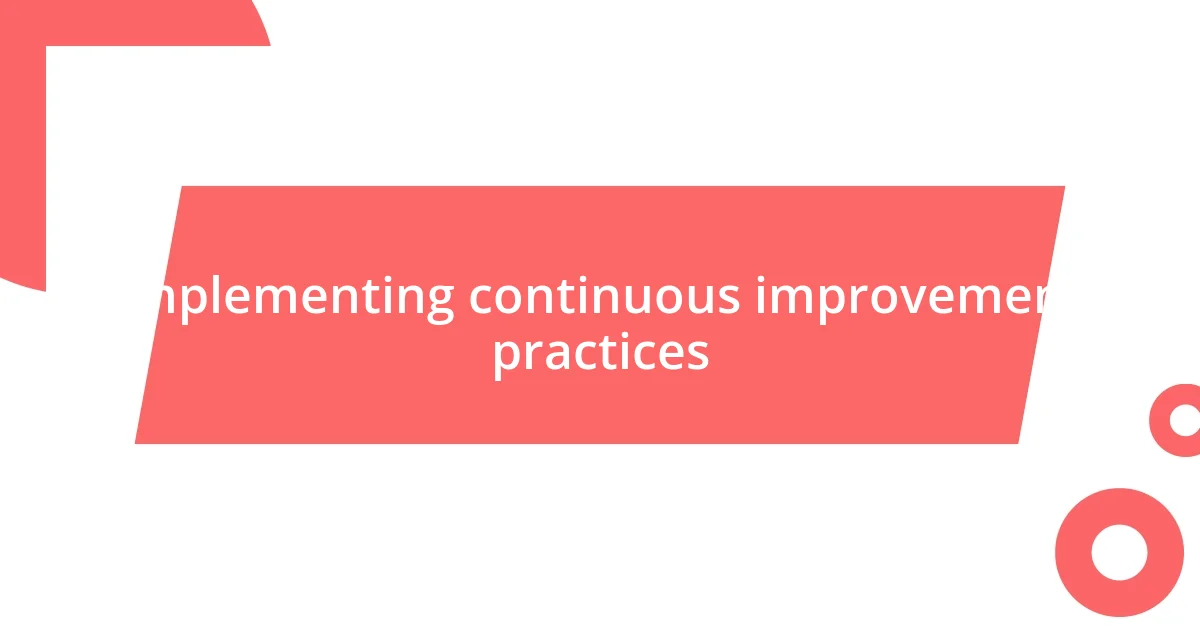
Implementing continuous improvement practices

Implementing continuous improvement practices
Implementing continuous improvement practices has been a game changer in my teaching approach. I recall a project where I engaged students in setting specific learning goals at the beginning of the semester. Watching them take ownership of their learning paths was inspiring! It felt like I was handing them the keys to their educational journey, and the responsibility invigorated them. Have you ever noticed how empowered students become when they have a say in their learning process?
A particularly impactful method I’ve found involves regular reflection sessions. At the end of each unit, I’d gather students to discuss what worked well and what didn’t. These candid conversations opened my eyes to their experiences, often illuminating blind spots in my instructional methods. Listening to their honest feedback was a humbling experience, but it reinforced an essential truth: continuous improvement thrives on open dialogue. Isn’t it fascinating how a simple conversation can lead to profound shifts in pedagogy?
Additionally, I’ve integrated small-scale trial implementations of new strategies, a practice I fondly refer to as “test and learn.” For example, I introduced a new collaborative project based on student suggestions and monitored its effectiveness over several weeks. The students felt excited and validated to see their ideas in practice, and I learned valuable lessons about engagement and teamwork. Who knew that trying out new practices based on direct student input would not only enhance their learning experience but also spark innovative approaches for me as an educator? It’s moments like these that remind me continuous improvement is truly a two-way street.
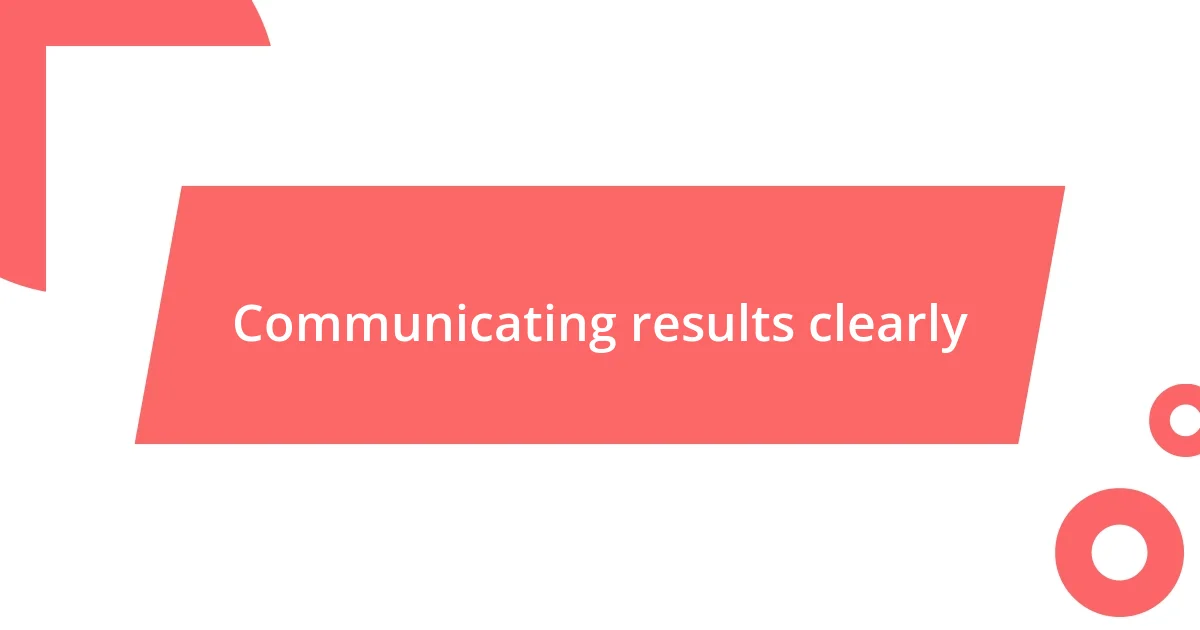
Communicating results clearly
When it comes to communicating results clearly, I can’t stress enough how important transparency is. There was a moment when I sat down with my students to go over their assessment scores together. As we reviewed each result, I noticed their faces light up or dim depending on how I framed the feedback. This experience made it crystal clear to me: how I communicate results can either motivate or discourage them. Have you ever witnessed the power of a single word in a student’s response?
I also find that breaking down complex data into relatable terms is key. For instance, instead of presenting a labyrinth of numbers, I started using straightforward language and metaphors my students could connect with. When I compared their growth to the stages of a video game, suddenly the numbers gained context—they weren’t just scores; they represented levels achieved and challenges faced. It was a game-changer in how they perceived their own progress.
Moreover, I’ve learned the significance of soliciting feedback on the communication process itself. After discussing their results, I’d often ask my students how they felt about the way I shared the data. This simple question not only gave me insight into their perceptions but also fostered an environment of mutual respect. Listening to their suggestions made me realize that effective communication is a two-way street. Have you tried inviting your students to shape the narrative around their performance? It’s enlightening to hear them share what resonates and what doesn’t.

